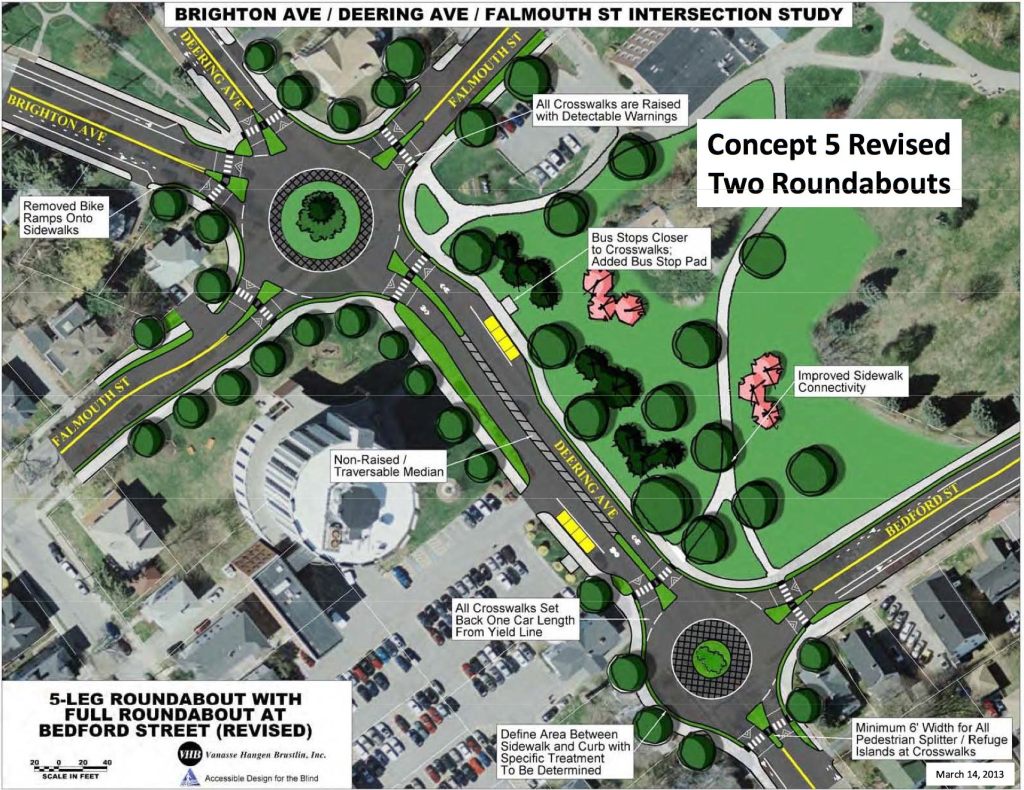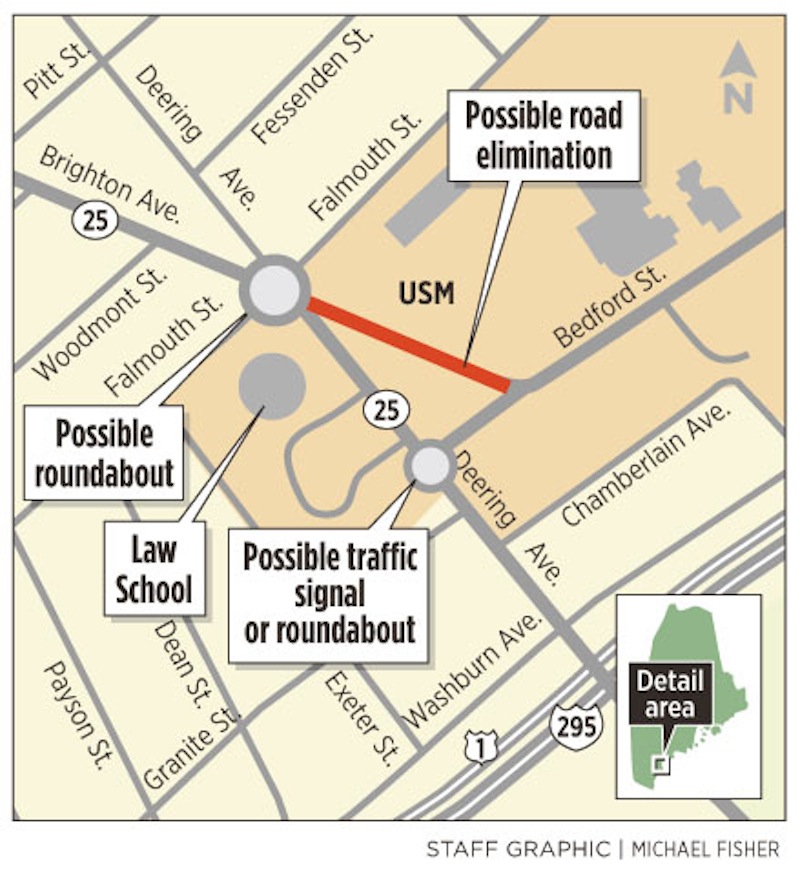PORTLAND – City planning staff have recommended creating two roundabouts on Deering Avenue to improve traffic flow near the University of Southern Maine.
However, some city councilors are concerned about the need to obtain private property and whether the traffic circles would make crossing the street more difficult for visually impaired pedestrians.
The roundabouts are being proposed at the six-way Falmouth Street, Deering Avenue and Brighton Avenue intersection as well as at the Deering Avenue and Bedford Street intersection.
The two projects would require the city to obtain — whether through a voluntary sale or eminent domain — 10,880 square feet of property, including 2,850 square feet of private property.
“At this point I’m still cautious about roundabouts,” said City Councilor David Marshall. “I’m concerned about the land we’d have to take from the abutters.”
Marshall chairs the council’s Transportation, Energy and Sustainability Committee, which will take up the proposal at 5:30 p.m. Wednesday
On average, more than 10,000 vehicles a day pass through the larger intersection in both directions on Brighton Avenue, according to the Maine Department of Transportation.
The city has been studying ways to improve safety at the six-legged intersection for more than a year.
USM has contributed $250,000 toward the project, including $7,000 for Massachusetts-based traffic consultant Vanasse Hangen Brustlin Inc., which designed the alternatives.
The committee and staff have whittled a variety of proposed changes down to two. Both would eliminate the short section of Brighton Avenue between the existing traffic light and Bedford Street, presenting an opportunity for more green space and walkways near the campus.
The alternatives differ in how they would calm traffic. One would rely on roundabouts at the Deering-Bedford and Deering-Falmouth-Brighton intersections, while the other would add a traffic signal at Deering Avenue and Bedford Street and an additional lane on Deering Avenue.
Both proposals would decrease congestion and traffic cutting through the neighborhood, and improve safety for automobiles, pedestrians and bicyclists, according to Bruce Hyman, the city’s bicycle and pedestrian program coordinator and program manager.
Installing two roundabouts would cost the city $1.5 million, not including the costs of acquiring the private property, reducing the six-way intersection near the University of Maine School of Law Library to five ways.
The cost of signalizing the Bedford Street intersection and adding a lane on Deering Avenue would cost $1.3 million.
The assessed value of the private property needed for the installation of roundabouts is about $33,000, according to city staff.
“Costs of property acquisition at this time are highly speculative and variable,” Hyman wrote in a March 14 memo to the committee.
The option of adding a signal at Bedford would require at least 50 square feet of private land, according to the memo.
City Councilor Cheryl Leeman, who serves on the committee, said she looks forward to hearing the public’s opinion about the proposals. However, she is concerned about property issues associated with the roundabouts.
“I’m concerned about the taking of the land,” Leeman said. “And it’s more costly.”
Hyman said the city has not yet reached out to the three landowners who may be affected. “We are very much in the conceptual stage,” he said.
Carol Schiller, president of the University Neighborhood Organization, said residents would prefer to have roundabouts, provided they can be safely navigated by emergency vehicles and those who are blind or visually impaired.
“(Roundabouts) will give this area an aesthetic face lift,” Schiller said.
Hyman said staff is recommending the roundabouts because they more effectively reduce the number and severity of automobile accidents. They also present a better opportunity to build a gateway to the university area, he said.
“Between the two concepts, we felt the roundabouts transform the look, feel and function of that intersection,” he said. “It’s an opportunity to go above and beyond what the traffic signal would provide.”
Concerns about whether roundabouts would be difficult or unsafe for blind and visually impaired pedestrians led the city to consult experts and modify the preferred design. The upgrades include raised crosswalks, detectable warnings and refuge islands.
If the transportation committee votes on a recommendation as expected Wednesday, Hyman said staff will incorporate it into a final report expected to go to the full council in May.
But the project’s start date, he said, would depend on when and if the city can secure state and federal money, which could take several years.
Randy Billings can be contacted at 791-6346 or at:
rbillings@mainetoday.com
Copy the Story Link
Send questions/comments to the editors.





Success. Please wait for the page to reload. If the page does not reload within 5 seconds, please refresh the page.
Enter your email and password to access comments.
Hi, to comment on stories you must . This profile is in addition to your subscription and website login.
Already have a commenting profile? .
Invalid username/password.
Please check your email to confirm and complete your registration.
Only subscribers are eligible to post comments. Please subscribe or login first for digital access. Here’s why.
Use the form below to reset your password. When you've submitted your account email, we will send an email with a reset code.